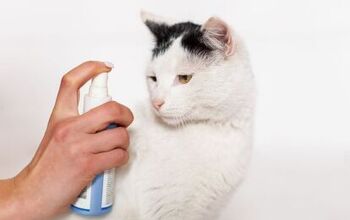How to Make a DIY Cat Deterrent Spray

As a cat parent, we love our feline friends, but let’s be honest, sometimes their natural instincts can seriously clash with our home décor. The frustration of discovering claw marks on your favorite sofa, finding your beloved houseplants overturned and dug up, or worse, dealing with territorial marking in your house is an experience that many of us share.
I understand the desire to find a humane and effective solution to protect our homes without harming our cats. After all, our cats are family, and we want to coexist peacefully. The goal is not to punish them but to guide their behavior in a positive direction.
Cat deterrent sprays offer several advantages, discouraging our kitties from engaging in unwanted behaviors in specific areas. Creating a DIY cat deterrent spray may be the perfect option for those seeking a budget-friendly solution or who like to control the substances coming into their home.
In this article, I’ll share how to make a safe and effective cat deterrent spray. Plus, I’ll discuss the other factors to consider when setting your cat up for success, including long-term behavior medication, positive reinforcement, and other cat-proofing options.
Understanding Cat Behavior
Before I go into the details about making and using a cat deterrent spray, let’s step back and start at the beginning. It’s essential to understand why cats engage in the behaviors we find problematic.
Scratching, for example, is far more than just a destructive behavior. It’s a natural instinct that serves many important purposes, including:
- Claw Maintenance: Allowing them to shed old nail sheaths
- Territorial Marking: Leaving both a visual and scent cue
- Emotional Release: A way to express frustration or excitement
Similarly, marking (often through spraying urine or rubbing cheeks) is also a form of communication. Cats use scent to establish territory, signal their presence, and even share their emotions like stress or anxiety.
Is your cat urinating outside their litter box? There are several possible reasons why your cat is doing their business in an unwanted location, including medical issues, stress, or problems with the litter box itself (location, type of litter, type of litter box, etc.). The first step to finding a solution is to make an appointment with your veterinarian to rule out any underlying medical conditions before considering it a behavioral problem.
Suppressing these behaviors with a deterrent spray isn’t a long-term solution. Instead, you will need to identify the root cause of the problem and address it directly.
For example, if your cat is scratching your furniture, try offering several scratching posts in various materials and locations to redirect their instincts to a positive outlet. Enriching their environment with toys, climbing structures, and interactive play can alleviate boredom and reduce stress-related marking.
If your cat is experiencing anxiety, I recommend consulting a cat behaviorist. These professionals are uniquely skilled at identifying triggers and can help you develop a tailored plan to create a more positive home environment for your best friend.
Finally, it’s important to remember that cats experience scents far differently than we do. Their sense of smell is far more sensitive than ours, allowing them to detect and identify subtle differences and interpret information from a scent we can’t. This is why they use scent as a significant part of their communication. This sensitive sense of smell is also why scents like citrus or vinegar are so effective at discouraging your cat from going in or near areas that you’re trying to protect.
Choosing the Right Ingredients
Onto the reason you’re reading this – how to make your own DIY cat deterrent spray. Selecting the right ingredients is crucial for both effectiveness and your cat’s safety. Essential oils, concentrated plant extracts, are popular as they offer strong scents that work well to deter cats. However, not all essential oils are safe for use around cats. Most importantly, even those that are safe for use around your cat must be handled and used with safety in mind.
Always dilute essential oils significantly and consult your veterinarian before using them on your cat. Some essential oils can be extremely harmful, even fatal, if ingested, inhaled, or even absorbed through their skin.
Luckily, several essential oils are considered safe and effective in diluted forms for cat deterrents. Citrus oils like orange and lemon often serve as the active ingredient in deterrent sprays as cats generally dislike their strong scents. While calming for humans, lavender can also act as a strong deterrent, but it should be used with caution and in very dilute form. Finally, eucalyptus and peppermint can be used, but sparingly and always diluted, as their strong menthol scents can be overwhelming and potentially irritating.
Some essential oils are absolutely toxic to cats and should be avoided entirely. Tea tree oil, pennyroyal, wintergreen, pine, and many others can cause severe health problems, including liver damage, respiratory distress, and even death. These oils should never be used on or near your cat.
Beyond essential oils, other ingredients (depending on your recipe) include:
- White Distilled Vinegar: Diluted with water, this is a common choice due to its strong, acidic scent
- Citrus Peels: A natural by-product of consuming citrus fruits, can be steeped in water to create a safe and effective citrus-scented deterrent
- Water: Serves as the base for all these sprays, diluting the other ingredients and allowing for easy application
A carrier oil, such as coconut or almond, is essential if you choose to use essential oils. Diluting essential oils in a carrier oil before adding them to water prevents skin irritation and ensures a more even scent distribution.
Finally, when possible, opt for organic ingredients. This minimizes the pesticides and other potentially harmful chemicals your cat may be exposed to, helping to create a healthier environment for your best friend.
My Go-To DIY Cat Deterrent Spray Recipe
This recipe uses the strong scent of citrus peels that you may already have hanging around your home, boiled to extract their essential oils, and enhanced with lemon juice and a touch of lemon-scented dish soap. The dish soap is a key ingredient, as it helps the spray stick to surfaces like plant leaves and furniture fabrics, making it last longer and work more effectively.
Ingredients:
- 2 cups water
- 1 cup of orange, lemon, lime, and/or tangerine peels
- 2 teaspoons lemon juice
- A squirt or two of lemon-scented dish soap
Instructions:
- Place the citrus peels and water into a medium-sized pot. Turn the heat to high and bring the mixture to a rolling boil.
- Once boiling, reduce the heat to low and let the mixture simmer for 20 minutes. This allows the citrus oils to infuse into the water.
- Remove the pot from the heat and allow the liquid to cool completely, which should take about 30 minutes. Once cooled, strain the mixture using a fine-mesh sieve or cheesecloth to remove all the citrus peels.
- Pour the strained liquid into a clean spray bottle. Add the lemon juice and a small squirt of lemon-scented dish soap to the bottle.
- Secure the spray bottle top and shake the bottle vigorously for a few seconds to ensure all the ingredients are fully combined.
- Now, you can spray the solution in areas where you want to discourage your cat from going. Remember to do a test spray in a hidden area first.
How to Use a Deterrent Spray Effectively
As previously mentioned, your newly created DIY cat deterrent spray is a deterrent, not a solution. It’s a training tool to help discourage unwanted behaviors, but it won’t teach your cat new ones. Therefore, it should always be used in conjunction with positive reinforcement. Simply spraying an area and expecting your cat to understand is unrealistic. You need to provide other outlets for their natural instincts while also communicating that those outlets are acceptable.
Introduce the spray gradually. Start by spraying a small amount onto a cloth or cotton ball and place this cloth near the area you’re concerned about. Allow your cat to investigate this new scent at their own pace. This will allow them to associate the smell with that specific location without feeling overwhelmed.
Once they show a clear aversion to the scented cloth, you can lightly spray the areas you want to protect, such as your furniture, carpets, houseplants, or any other spots where your cat is demonstrating the unwanted behavior in question. Consistency is key! Reapply the spray regularly, especially after cleaning the area, as the scent will dissipate over time. Remember, the goal is to create a consistent and unpleasant scent association for your cat in those specific spots in your home.
In addition to introducing this new scent, you will also need to address the underlying cause of the behavior. For example, if your cat is scratching your furniture, you should consider placing multiple scratching posts of various materials around your home, such as sisal, carpet, or cardboard. If you see your cat scratching on one of their scratch posts, reward them to reinforce that good behavior.
If your cat engages in destructive behavior due to boredom, try increasing the number of play sessions you share. You can also add enrichment opportunities to their space and their daily routine, such as climbing structures, cat shelves, toys, and window perches.
Finally, remember that behavior modification takes time and patience. Your cat won’t change overnight. Be understanding, patience, and consistent in your approach. Take time to celebrate the small victories along the way. You can turn these unwanted behaviors around with a combination of deterrents, positive reinforcement, and addressing underlying causes.
Creating Harmony (on a Budget) with DIY Cat Deterrent Sprays
DIY cat deterrent sprays can be a valuable tool in addressing and, ultimately, eliminating unwanted behaviors from your cat. However, their effectiveness lies in combining your new spray with positive reinforcement and a deep understanding of your cat’s natural instincts.
These sprays are not a magic wand but rather a supporting piece of a much bigger behavior modification puzzle. By understanding why your cat engages in certain behaviors, you can address the root cause and provide suitable alternatives, where possible. For example, you can help eliminate destructive scratching by offering scratching posts.
I have shared my go-to deterrent spray, but if you find you aren’t getting the results you’re looking for, I encourage you to experiment with different recipes and ingredients. Each cat is unique, and what works for one may not work for another. Don’t be afraid to try different combinations to find the perfect option for you and your cat.
Ultimately, your cat’s health, happiness, and well-being are top priorities. Creating a safe and enriching environment, coupled with positive reinforcement, will help you build a strong bond and lead to long-term behavioral success.
Join the PetGuide community. Get the latest pet news and product recommendations by subscribing to our newsletter here.

Britt Kascjak is a proud pet mom, sharing her heart (and her home) with her “pack” which includes her husband John, their 2 dogs – Lucifer and Willow – and their 3 cats – Pippen, Jinx, and Theia. She has been active in the animal rescue community for over 15 years, volunteering, fostering and advocating for organizations across Canada and the US. In her free time, she enjoys traveling around the country camping, hiking, and canoeing with her pets.
More by Britt
























